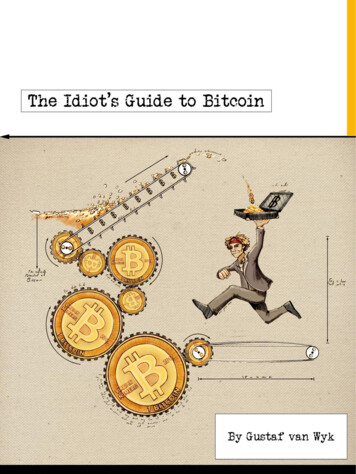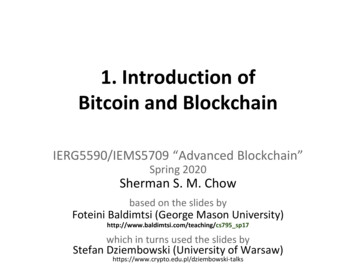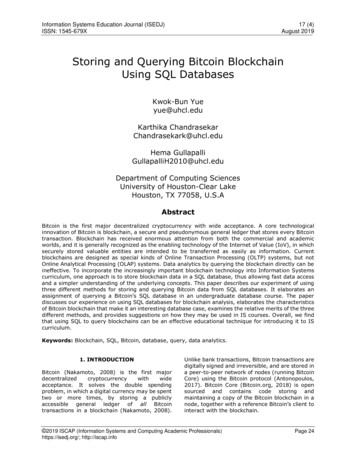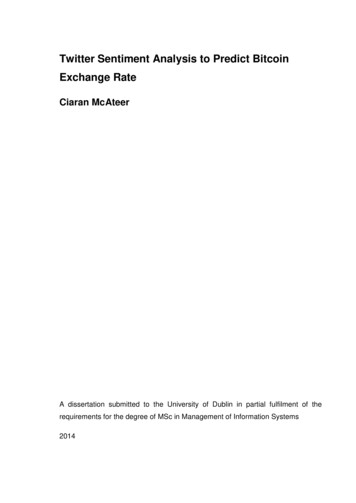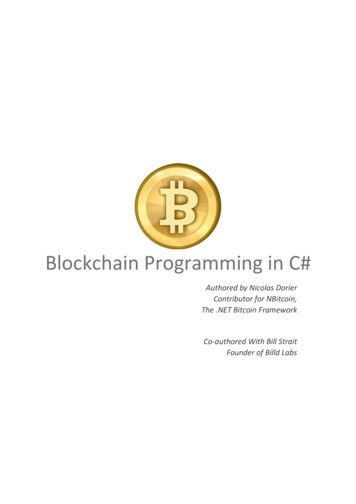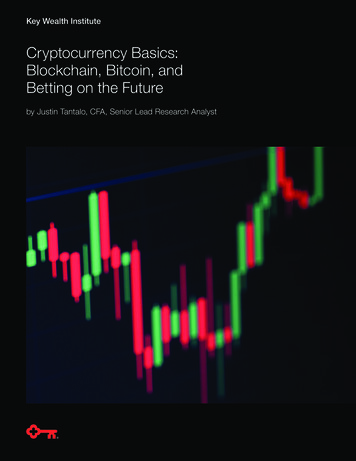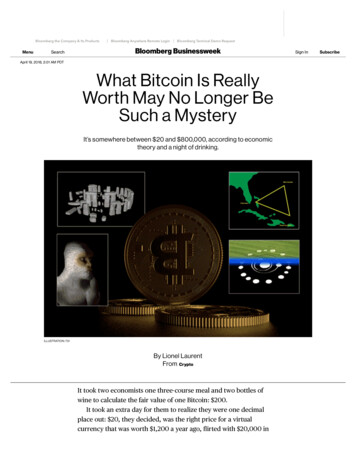
Transcription
Bloomberg the Company & Its ProductsMenuSearchBloomberg Anywhere Remote LoginBloomberg Terminal Demo RequestBloomberg BusinessweekApril 19, 2018, 2:01 AM PDTWhat Bitcoin Is ReallyWorth May No Longer BeSuch a MysteryIt’s somewhere between 20 and 800,000, according to economictheory and a night of drinking.ILLUSTRATION: 731By Lionel LaurentFrom CryptoIt took two economists one three-course meal and two bottles ofwine to calculate the fair value of one Bitcoin: 200.It took an extra day for them to realize they were one decimalplace out: 20, they decided, was the right price for a virtualcurrency that was worth 1,200 a year ago, flirted with 20,000 inSign InSubscribe
December, and is still around 8,000. Setting aside the fortunes loston it this year, Bitcoin, by their calculation, is still overvalued, to thetune of about 40,000 percent. The pair named this the Côtes duRhône theory, after the wine they were drinking.“It’s how we get our best ideas. It’s the lubricant,” says SavvasSavouri, a partner at a London hedge fund who shared drinking andthinking duties that night with Richard Jackman, professor emeritusat the London School of Economics. Their quest is one shared by thelegions of traders, techies, online scribblers, and gamblers andgrifters mesmerized by Bitcoin. What’s the value of a cryptocurrencymade of code with no country enforcing it, no central bankcontrolling it, and few places to spend it? Is it 2, 20,000, or 2million? Can one try to grasp at rational analysis, or is this just themadness of crowds?Answering this question isn’t easy: Buying Bitcoinwon’t net you any cash flows, or any ownership of theblockchain technology underpinning it, or reallyanything much at all beyond the ability to spend orsave it. Maybe that’s why Warren Buffett once said theidea that Bitcoin had “huge intrinsic value” was a“joke”—there’s no earnings potential that can be usedto estimate its value. But with 2 billion pumped intocryptocurrency hedge funds last year, there’s a lot ofmoney betting the punchline is something other thanzero. If Bitcoin is a currency, and currencies have value, surely somekind of stab—even in the dark—should be made at gauging its worth.Writing on a tablecloth, Jackman and Savouri turned to thequantity theory of money. Formalized by Irving Fisher in 1911, withorigins that go back to Copernicus’s work on the effects of debasingcoinage, the theory holds that the price of money is linked to itssupply and how often it’s used.Here’s how it works. By knowing a money’s total supply, itsvelocity—the rate at which people use each coin—and the amount ofgoods and services on which it’s spent, you should be able tocalculate price. Estimating Bitcoin’s supply at about 15 million coins(it’s currently a bit more), and assuming each one is used an averageof about four times a year, led Jackman and Savouri to calculate that60 million Bitcoin payments were supporting their assumed 1.2billion worth of total U.S. dollar-denominated purchases. Using thetheory popularized by Fisher and his followers, you can—simplifyingthings somewhat—divide the 1.2 billion by the 60 million Bitcoinpayments to get the price of Bitcoin in dollars. That’s 20.So far, so straightforward. It turns out, however, that when itcomes to putting a price on Bitcoin, the same equation can yield
many different answers. In September, Dan Davies, an analyst atfinancial research firm Frontline Analysts Ltd., wrote up a“guesstimate” of Bitcoin’s value that he’d originally conducted in2014 using—again—the quantity theory of money. He plugged inestimates for each variable and got about 600.On Dec. 10, Mark Kirker, a high school math teacher in California,published an analysis online using the same equation for the samepurpose. He concluded that Bitcoin should be way above thencurrent levels. He’s since revised the number. Contacted byBloomberg, he says it could be 15,000.How can something be worth 20, 600, and 15,000 within thesame theory? One key reason stems from what we don’t know aboutcryptocurrencies rather than what we do know. We know Bitcoin’smaximum supply is 21 million, and we know the velocity of mostcommonly used currencies. We don’t know how widely Bitcoin willbe adopted tomorrow, how frequently it will transact, or what it willbe used for. In Davies’s example, a guide to Bitcoin’s future potentialwas the illicit drugs market, an obvious home for more-or-lessuntraceable digital cash. The United Nations has estimated thismarket at 120 billion. Plugging in that number helped Davies get to 600.For Kirker, though, drugs and criminals are only part of the story.
He imagines including the output of some developing countrieswhere cryptocurrencies might have better takeup than traditionalbanking. But with so much up in the air, the equation starts to lookless like algebra and more like alchemy. Even in the non-Bitcoinworld, the velocity of money and its price can fluctuate in ways notpredicted by fundamental analysis. “I am not wholly surprised itdoesn’t pin down a price target to within a factor of 100 either way,”Davies says.Some believe the cloud of confusion has to do with the simple factthat cryptocurrency is something entirely new—it needs a freshschool of economic thinking to go with it. A quantity theory ofcryptomoney, perhaps.John Pfeffer, formerly a partner at KKR & Co., has written severalpapers to this effect, arguing that technology is turning the centuriesold equation on its head. Bandwidth and computing resources arethe fuel of cryptocurrencies, and they need their place in quantitytheory, he argues. His version of the equation imagines a world inwhich more powerful computers and faster connection speedscombine to lower the cost of maintaining a crypto-economy overtime, while the same forces radically increase the availability andspeed of its digital coins. There already exist hundreds of tokensother than Bitcoin, pointing to a world where digital currencies are,well, a dime a dozen.In a future where cryptocurrencies become a formof economic resource (like fuel, water, or electricity)that’s computerized and commoditized, wouldanyone get rich from hoarding them in her tradingaccount? No, says Pfeffer. In his view, the more widelyused a particular brand of digital cash becomes, thehigher the probability its value tends toward zero. Inquantity theory terms, cryptocoins’ velocity could goway, way up, while the cost of many services withinthe crypto-economy could go way, way down. Cryptocould change the world and still leave a lot of people with worthlesstokens.Pfeffer dangles one hope in front of the Bitcoin faithful who dreamof riches: the possibility there’s one cryptocurrency out there thatwill serve as a store of value for the digital world. Like gold, a metalseen by investors as a haven in times of crisis or when the purchasingpower of cash is eroding, whichever coin wins that crown will have acompletely different use—and price—than the rest. Applying thisthinking to Bitcoin, Pfeffer explains, would yield a price target of 260,000 to 800,000.Such a value would be not too far off 1 million—where the
frequently mocked, frizzy-haired self-help guru James Altucherexpects Bitcoin to be in 2020. Software entrepreneur John McAfeehas said it will hit 500,000. “If not, I will eat my d--- on nationaltelevision,” he tweeted. He later doubled his target price. Pfeffer hasbeen more careful than most in warning of significant risk ofinvestment loss. “This could all go substantially to zero for variousreasons,” he wrote in December.Putting a price on Bitcoin is therefore less about crunchingnumbers and more about deciding just what it is and what it couldbe, if anything. That’s appetizing for risk-hungry optimists in theventure capital world, who are accustomed to their investmentsturning into big hits or big flops. Ride-hailing service UberTechnologies Inc., for example, has lost an eye-watering amount ofmoney, yet it’s one of the most highly valued companies in the world.It’s a bet that more traditional investors would have difficultyjustifying using traditional metrics.But it also means science and snake oil sit side by side. Quantitytheory is one example of how an equation can be remodeled to fitdifferent scenarios or different wishes about where the price willland. And it’s not the only one: Network adoption, the cost curve ofBitcoin mining, and transaction volumes have all been bundled intomarketable literature advising traders and investors on what to buy.It’s a thick numbers soup. At least Uber has financial accounts toreview.Those with long memories also remember the quantitativeanalyses that underpinned the hot new asset classes of the past, fromdot-com stocks to securitized art. These were often sold to investorsas new metrics and radical investment theses, only to be ditchedwhen a recession or panicked sell-off hit. “They’re always talkingabout a new paradigm, but I say it’s the same meat, different gravy,”says Côtes du Rhône theorist Savouri, who maintains traditionaleconomic theory should be embraced rather than ignored by theBitcoin faithful.For Savouri, the easiest way to understand the efflorescence oftheories and valuations being bandied about is to opt for a simple,overarching one: the greater fool theory. It says that one fool buys inthe hope that there’s an ever-bigger sucker willing to pay more. “Theproblem,” he says, “is that we don’t breed fools geometrically.”Lionel Laurent is a reporter for Bloomberg Gadfly.Follow @crypto on Twitter for the latest news.
Bloomberg the Company & Its Products Bloomberg Anywhere Remote Login Bloomberg Terminal Demo Request Menu Search Bloomberg Businessweek Sign In Subscribe. December, and is still around 8,000. . a guide to Bitcoin's future potential was the illicit drugs market, an obvious home for more-or-less-untraceable digital cash. The United Nations .

